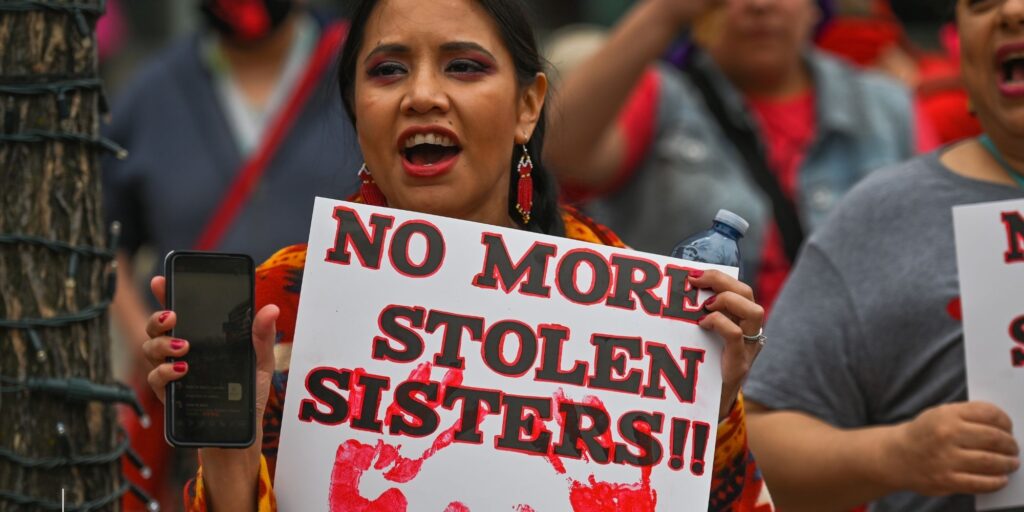Red Dress Day, the National Day of Awareness for Missing and Murdered Indigenous Women and Girls and Two-Spirit People (MMIWG2S), is observed annually on May 5. People mark the day by hanging red dresses from trees, windows, fences, and balconies. The dresses are visual reminders of the thousands of missing Indigenous people in Canada.
Through our shared values of belonging, excellence, connection, discovery and celebration, Grandview Kids commits to seeking truth and upholding reconciliation. That is why we acknowledge and seek to spread awareness about the importance of Red Dress Day for clients, caregivers, staff, partners and the community.

Why this matters
In its 2019 report, the National Inquiry into Missing and Murdered Indigenous Women and Girls said the crisis constitutes a genocide of Indigenous people, citing, “Indigenous women are 12 times more likely to be murdered or go missing than other women in Canada, and 16 times more likely to be killed or disappear than white women. The report also cited research from Statistics Canada showing Indigenous women and girls accounted for almost a quarter of female homicide victims between 2001 and 2015,” though they represent only 5 percent of women in Canada.
Amnesty International notes that, currently, Indigenous women make up 16 percent of all femicide victims and 11 percent of all missing women. Indigenous women, girls and 2SLGBTQQIA+ peoples are also six times more likely to be murdered than their non-Indigenous counterparts. These high rates of violence have drawn widespread expressions of concern from national and international human rights authorities, which have repeatedly called for Canada to address the problem.
How the movement began
The roots of Red Dress Day can be traced back to the powerful art project of Canadian Métis artist Jaime Black. In 2010, Black initiated the “REDress Project” as a visual reminder of the staggering number of missing and murdered Indigenous women across Canada. Black-hung red dresses in public spaces, from trees to lamp posts, create a stark contrast against the landscape, evoking both sorrow and resilience.
What started as an art installation soon morphed into a movement.
Indigenous Peoples, allies and advocates across Canada and beyond embraced the symbolic red dress as a rallying cry for awareness and action. Red Dress Day emerged as an annual event, bringing people together to honour the lives lost and demand justice for the victims and their families.
Get involved
People are encouraged to wear a red dress, display red dresses in public spaces, or put a red light outside their doors. Gatherings such as ceremonies, marches, vigils and events are planned across the country. The events serve as places for people to come together and share their sorrow, anger, grief and hope for a better future.
- Educate yourself by reading the National Inquiry into Missing and Murdered Indigenous Women and Girls.
- Read Tiny House Warrior Kanahus Manuel’s powerful interview with Gender Rights Campaigner Elishma Noel Khokhar to learn more about the threats faced by Indigenous women and gender-diverse people on the frontlines of land and water defence.
The lands, waters, nature and sky that Grandview Kids is privileged to exist within have long been home to the Michi Saagiig Anishinaabeg. We acknowledge the lands of the traditional and treaty territories covered under the Williams Treaties, including the Mississaugas of Scugog Island First Nation, Alderville First Nation, Hiawatha First Nation, Curve Lake First Nation and the Chippewa Nation of Georgina Island, Beausoleil and Rama. We are responsible for building stronger relationships with clients, caregivers, partners and colleagues from First Nations, Métis and Inuit communities.
Check out more Grandview Kids articles
- Team Grandview achieves Accreditation with Exemplary Standing, receiving a perfect score
- “Grandview Kids became my life raft” – International Day for People with Disabilities
- December: Dates of Significance
- From the search for support to finding a village: Celebrating Giving Tuesday
- Scarlett sparkles with hope in every step: Grandview Kids 2025 Holiday Campaign
